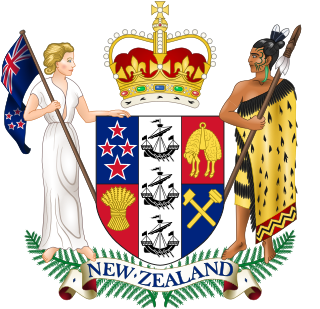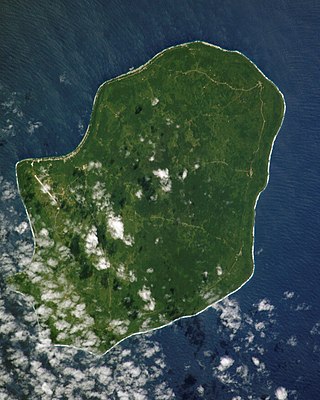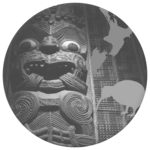
"God Save the King" is the national anthem of the United Kingdom and the royal anthem of each of the British Crown Dependencies, one of two national anthems of New Zealand, and the royal anthem of most Commonwealth realms. The author of the tune is unknown and it may originate in plainchant, but an attribution to the composer John Bull has sometimes been made.
Aotearoa is the Māori-language name for New Zealand. The name was originally used by Māori in reference only to the North Island, with the whole country being referred to as Aotearoa me Te Waipounamu. In the pre-European era, Māori did not have a collective name for the two islands.

The culture of New Zealand is a synthesis of indigenous Māori, colonial British, and other cultural influences. The country's earliest inhabitants brought with them customs and language from Polynesia, and during the centuries of isolation, developed their own Māori and Moriori cultures. British colonists in the 19th century brought Western culture and had a dramatic effect on the indigenous inhabitants, spreading Western religious traditions and the English language. Over time, a distinct Pākehā or New Zealand European culture emerged.
A national anthem is a patriotic musical composition symbolizing and evoking eulogies of the history and traditions of a country or nation. The majority of national anthems are marches or hymns in style. American, Central Asian, and European nations tend towards more ornate and operatic pieces, while those in the Middle East, Oceania, Africa, and the Caribbean use a more simplistic fanfare. Some countries that are devolved into multiple constituent states have their own official musical compositions for them ; their constituencies' songs are sometimes referred to as national anthems even though they are not sovereign states.

"Stand and Sing of Zambia, Proud and Free" is the national anthem of Zambia. The tune is taken from the hymn "Nkosi Sikelel' iAfrika", which was composed by Xhosa composer Enoch Sontonga, in 1897. The lyrics were composed after Zambian independence to specifically reflect Zambia, as opposed to Sontonga's lyrics, which refer to Africa as a whole.
"The Banner of Freedom", known also as "Sāmoa Tulaʻi" is the national anthem of Samoa. Both the words and the music were composed by Sauni Iiga Kuresa. The anthem was composed in response to a public competition to select a new anthem when the United Nations conferred self-government on Samoa in 1948 and was chosen from among 15 entries. It was performed publicly for the first time on 1 June 1948 and was subsequently played at all public ceremonies attended by the High Commissioner and performed after "God Save the Queen" on official occasions. It was retained as the national anthem upon Samoa's gaining of independence from New Zealand in 1962.

The monarchy of New Zealand is the constitutional system of government in which a hereditary monarch is the sovereign and head of state of New Zealand. The current monarch, King Charles III, acceded to the throne following the death of his mother, Queen Elizabeth II, on 8 September 2022 in the United Kingdom. The King's elder son, William, Prince of Wales, is the heir apparent.

The coat of arms of New Zealand is the heraldic symbol representing the South Pacific island country of New Zealand. Its design reflects New Zealand's history as a bicultural nation, with a European female figure on one side and a Māori rangatira (chief) on the other. The symbols on the central shield represent New Zealand's trade, agriculture and industry, and a Crown represents New Zealand's status as a constitutional monarchy.

The Māori King Movement, called the Kīngitanga in Māori, is a movement that arose among some of the Māori iwi (tribes) of New Zealand in the central North Island in the 1850s, to establish a role similar in status to that of the monarch of the British colonists, as a way of halting the alienation of Māori land. The Māori monarch operates in a non-constitutional capacity with no legal or judicial power within the New Zealand government. Reigning monarchs retain the position of paramount chief of several iwi and wield some power over these, especially within Tainui.

The Realm of New Zealand is the area over which the monarch of New Zealand is head of state. The realm is not a federation but is a collection of states and territories united under its monarch. New Zealand is an independent and sovereign state that has one territorial claim in Antarctica, one dependent territory (Tokelau), and two associated states. The Realm of New Zealand encompasses the three autonomous jurisdictions of New Zealand, the Cook Islands, and Niue.

"Ko e Iki he Lagi", also titled in English as "Lord in heaven, Thou art merciful", is the national anthem of Niue. It was adopted in 1974, when Niue became a self-governing state within the realm of New Zealand.
New Zealanders of European descent are mostly of British and Irish ancestry, with significantly smaller percentages of other European ancestries such as Germans, Poles, French, Dutch, Croats and other South Slavs, Greeks, and Scandinavians. European New Zealanders are also known by the Māori-language loanword Pākehā.

Tokelau, a dependent territory of New Zealand, adopted an official flag in 2009. Previously, the flag of New Zealand was used as the official flag for Tokelau.

New Zealand is an island country in the southwestern Pacific Ocean. It consists of two main landmasses—the North Island and the South Island —and over 700 smaller islands. It is the sixth-largest island country by area and lies east of Australia across the Tasman Sea and south of the islands of New Caledonia, Fiji, and Tonga. The country's varied topography and sharp mountain peaks, including the Southern Alps, owe much to tectonic uplift and volcanic eruptions. New Zealand's capital city is Wellington, and its most populous city is Auckland.

"Te Atua Mou Ē" is the national anthem of the Cook Islands. It was adopted in 1982, replacing the previous New Zealand anthem "God Defend New Zealand".

The Seal of Niue, or the Public Seal of Niue, is the official seal of Niue. It was adopted in September 2021. The first version of the seal was created in 1974 when Niue gained self-governing status and joined into free association with New Zealand.

The national badge of Tokelau depicts a tuluma, which is a traditional Tokelauan carved wooden “tackle box” used by local fishermen. A white cross in the centre of the tuluma and the inscription below Tokelau mo te Atua reflect the strong influence of Christianity in Tokelau.

"God Defend New Zealand" is one of two national anthems of New Zealand, the other being "God Save the King". Legally the two have equal status, but "God Defend New Zealand" is more commonly used. Originally written as a poem, it was set to music as part of a competition in 1876. Over the years its popularity increased, and it was eventually named the second national anthem in 1977. It has English and Māori lyrics, with slightly different meanings. Since the late 1990s, the usual practice when performed in public is to perform the first verse of the national anthem twice, first in Māori and then in English.
There are six monarchies in Oceania where supreme power resides with an individual hereditary head, who is recognised as the head of state. Each is a constitutional monarchy, wherein the sovereign inherits his or her office, usually keeps it until death or abdication, and is bound by laws and customs in the exercise of their powers. Five of these independent states share King Charles III as their respective head of state, making them part of a global grouping known as the Commonwealth realms; in addition, all monarchies of Oceania are members of the Commonwealth of Nations. The only sovereign monarchy in Oceania that does not share a monarch with another state is Tonga. Australia and New Zealand have dependencies within the region and outside it, although five non-sovereign constituent monarchs are recognized by New Zealand, Papua New Guinea and France.
"Te Atua o Tokelau", or "Tokelau mo te Atua", is the anthem of Tokelau, a territory within the Realm of New Zealand. Adopted in 2012, it was written and composed by Eric Lemuelu Falima. As a Commonwealth realm, the official national anthem is "God Save the King".













